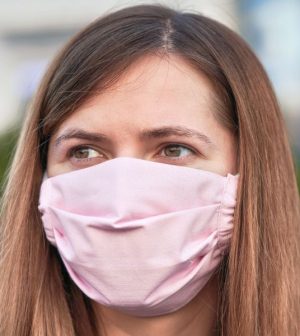- Navigating Your Midlife Crisis: Embracing New Possibilities
- City Raccoons Showing Signs of Domestication
- Mapping the Exposome: Science Broadens Focus to Environmental Disease Triggers
- One Week Less on Social Media Linked to Better Mental Health
- Your Brain Changes in Stages as You Age, Study Finds
- Some Suicide Victims Show No Typical Warning Signs, Study Finds
- ByHeart Formula Faces Lawsuits After Babies Sickened With Botulism
- Switch to Vegan Diet Could Cut Your Greenhouse Gas Emissions in Half
- Regular Bedtime Does Wonders for Blood Pressure
- Dining Alone Could Mean Worse Nutrition for Seniors
Masks Cut Distance Coronavirus Travels in Half, Study Finds

Face masks are touted as a key tool in preventing the spread of COVID-19, and a new study offers more proof that they work.
Florida researchers found face masks cut the distance that airborne pathogens such as the coronavirus can travel by more than half.
The findings suggest that some COVID-19 social distancing guidelines could be relaxed when people wear masks, according to the authors.
“The research provides clear evidence and guidelines that three feet of distancing with face coverings is better than six feet of distancing without face coverings,” said study co-author Kareem Ahmed. He’s an associate professor in the University of Central Florida department of mechanical and aerospace engineering.
For the study, Ahmed and colleagues used special instruments to measure the distance in all directions that droplets and aerosols traveled from 14 people, aged 21 to 31, when they spoke and coughed while wearing different types of masks or not wearing a mask.
Each participant recited a phrase and simulated a cough for five minutes without a face-covering, with a cloth face covering, and with a three-layered disposable surgical mask.
Airborne emissions produced by the participants when they spoke or coughed spread four feet in all directions when they had no mask, compared with about two feet when they wore a cloth face covering and about six inches when they wore a surgical mask, the investigators found.
The study was published Jan. 12 in the Journal of Infectious Diseases.
Learning more about how to reduce airborne transmission of infectious diseases can help keep people safe and manage responses to COVID-19 and other pandemics, according to the researchers.
The next step is to expand the study with more participants.
The idea for the study came from jet propulsion research conducted by the team.
“The principles are the same,” Ahmed said in a school news release. “Our cough and speech are exhausted propulsion plumes.”
More information
The U.S. Centers for Disease Control and Prevention offers a guide to masks.
SOURCE: University of Central Florida, news release, Jan. 12, 2022
Source: HealthDay
Copyright © 2025 HealthDay. All rights reserved.










